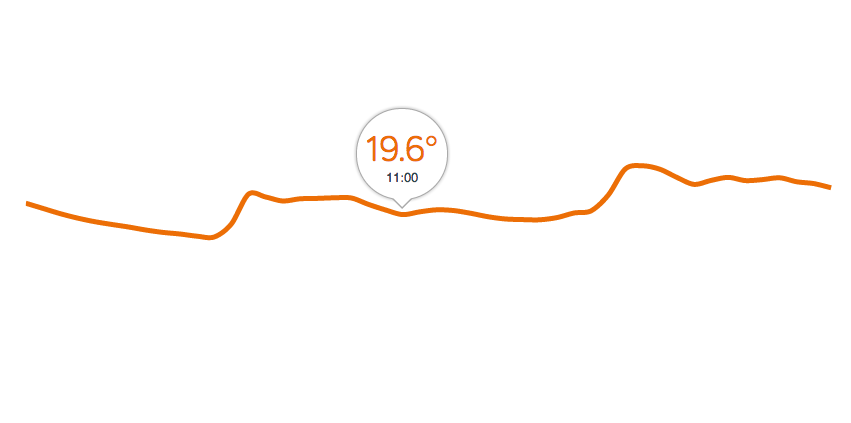24 hours with: Hive

It’s been a week where the tech world has got terribly excited about Google buying Nest, a connected central heating thermostat. And a week where I have also leapt into this world — buying Hive, the connected central heating thermostat from British Gas, one of the UK energy companies.
After posting about it on Google+, quite a few people have asked what it’s like: so I’ll tell you.
Hive costs £199 (about US$325), and for that you get a small box to plug into your broadband hub, a small box to wire into your boiler, a proper wireless thermostat for the wall, a mobile app (for Android and iOS), a website, and a man who comes and installs the whole thing for you.
Why did I buy it?
I have a gas boiler that does central heating (on a timer) and hot water (on-demand). Some people have their hot water on some kind of bizarre timer system which fills a tank or something, but I don’t understand the point of that (though Hive copes with that quite happily, using a different piece of equipment for a suitably-equipped boiler).
Three days a week it’s just me at home. I sit upstairs in the attic. It has no central heating in it, but it’s tiny, so a small electric convection heater sits by my side keeping me toasty warm. Accordingly, there is no point for the central heating to be on.
Four days a week, it’s me at home (in the attic for two days), plus my partner and my daughter. So, we want the central heating to be on then, because otherwise we get cold.
Additionally, often I am in town visiting clients, and therefore don’t need the heating on at all. No need to warm up an empty house, after all.
My old thermostat let me program “weekdays” and “weekends”. This was a bit pointless. Hence the requirement for a new thermostat which allowed a little more flexibility.
What’s it like then?
Glad you asked.
The wireless thermostat is a fully-functioned thermostat, enabling you to control the heating, and program a schedule, just as if the internet bit wasn’t there. That’s important, since I am a little nervous of a system that required use of a smartphone or a web browser. We won’t be in this house forever; and nor will we have an iOS or Android device forever.
However, I’ve not touched it, other than screw it to the wall; because I’ve programmed the central heating online, through the Hive website. Very simple: dragging and dropping “on/off” markers, and marking what temperature I wanted. You can also program the schedule through your smartphone, though it looks a little less easy.
It’s the smartphone app that makes it quite clever. From the smartphone, I can turn up the temperature, or turn off the heating altogether: and those changes appear instant. The interface is slick and built for speed. On the night we got it, we went to sleep earlier than normal, and I was able to turn the heating off while lying in bed.
The website also keeps some heating data: at the top of this page you’ll see the temperature in the house yesterday (when the heating was on all day). You can see the heating going on in the morning, turning itself down a little during the day, and then up again in the evening (accompanied by more people in the house and some cooking going on). I have a relatively old house with thick stone walls, so the temperature variation isn’t, actually, particularly great, which surprised me. The early morning low appears to be 18.5ºC (65ºF) which is only a few degrees lower than we normally have it. (It gets colder in the bedrooms, though.)
The website appears hackable — it uses JSON calls under the hood, though you need to have authenticated cookies so it isn’t for the faint-hearted. The company say they’re working on an API, too. I can see some hackers already working out how to — for example — turn off the heating if there’s nobody at home, or turn it on if it notices I’m on my way back.
Would you recommend it?
I don’t know what your circumstances are.
This device should save us money relatively quickly, since we have been relatively heavy users of central heating in the past year or so. The main saving is going to come from the fact I can turn the daytime heating off for three days a week, which has been difficult to do before now (that’s a total of 27 hours a week).
The additional connected functionality is nice: but really, it’s the connected user interface that makes this product so good. Setting and changing a central heating schedule isn’t particularly time-consuming: but significantly easier with a large colour screen and a track-pad. Turning on and off the heating on-demand is also certainly possible without any connection: but having that control in the palm of your hand means you are more likely to do it.
Hive has shown me the benefit of a clear user interface. Clear user interfaces — so sadly absent from much of our daily lives — trump mere functionality every time.
Later: someone asks “goodness, £199 will take a time to pay back, won’t it?”
At the very least, I’ll have the heating on at least 16% less than I did (based on total hours above). My energy bills are currently £108 a month, of which 64% (£69) of that is gas. It should therefore pay for itself by June 2015: just eighteen months.
(In actual fact, we’ve been leaving the heating on overnight, too, so the savings will be considerably greater: but that’s un-connected with this product.)